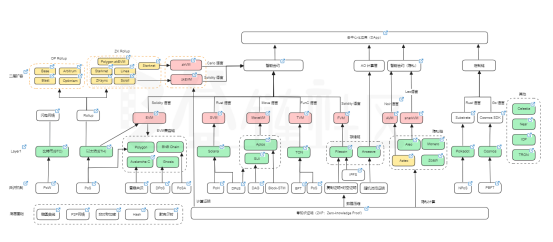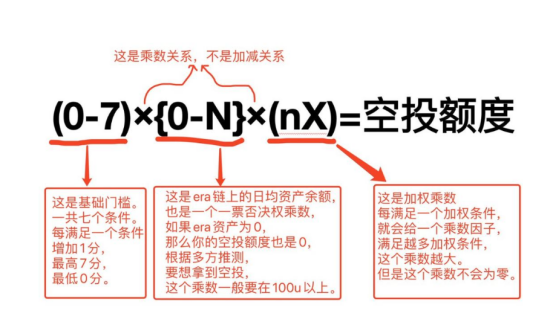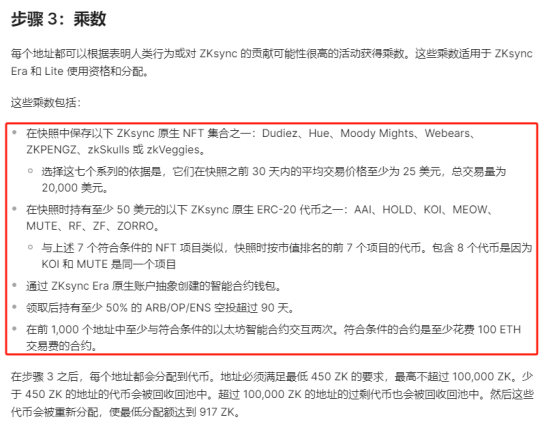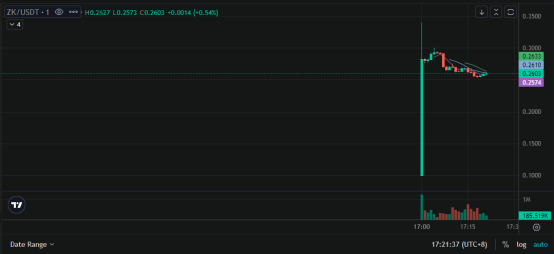
One airdrop after another in June, following LayerZero, another star project ZkSync has received the baton for airdrops.
However, unlike LayerZero, ZkSync's airdrop did not adopt extremely strict witch screening, showing a sense of universality. However, with controversial fund settings, suspicions of insider trading, and rules that excessively emphasize the project's discourse power, it has faced stronger community criticism and resistance.
Despite facing community disputes and various controversies, exchanges such as Binance and Bitget have successively announced the listing of ZK. The price weakening has also dragged ZK into a larger public opinion whirlpool.
It seems that ZkSync, which claims to be the last hope of L2, seems to have disappointed users the most.
Compared to the previous airdrop LayerZero, ZkSync, as one of the Ethereum L2 stars "F4" alongside Arbitrum, Optimism, and Starknet, has higher visibility and a longer history.
zkSync originated from EthCC in 2019, and the team is committed to developing and deploying Rollup with zkSNARK. At the beginning of 2020, with the outbreak of DeFi, the Ethereum ecosystem flourished, and the scalability issue became more prominent. At that time, the Rollup solution was the industry consensus for Ethereum's expansion technology path. However, the fraud proof adopted by OP has its natural flaws in waiting time and centralized verification. Therefore, ZK Rollup, which has cryptographic features and uses zero-knowledge proofs, became the focus of technical workers, and zkSync was born.

Web3 technology map, source: Chain News
In June 2020, zkSync's parent company Matter Labs officially released zkSync v1.0 on the Ethereum mainnet, using ZK Rollup to utilize zero-knowledge proof circuits to eliminate the risk brought by centralized validators, improve data availability, and bring a more efficient and scalable technical solution. As a result, zkSync became one of the projects most favored by Ethereum's founder, Vitalik Buterin.
From a technical perspective, zkSync has significant advantages in security and efficiency compared to OP Rollup, but it also has core issues—complex algorithms, high engineering difficulty, and poorer compatibility. In this context, zkSync's development is not considered rapid.
In June 2021, zkSync 2.0 testnet Era was released, and it was not until 2 years later, in March 2023, that the ZkSync mainnet was officially launched. However, with the deployment of the open-source mainnet zkEVM in the Ethereum Rollup ecosystem, ZkSync quickly gained popularity. Just 2 months after its launch, ZkSync Era's mainnet TVL reached 4.8 billion US dollars, with a weekly growth rate of nearly 20%, and the number of unique addresses reached 920,000, surpassing other Layer 2 networks such as Arbitrum, Optimism, and Starknet at that time.
For such projects, capital naturally does not miss out. In fact, the team behind zkSync, Matter Labs, comes from top global companies and has close ties to capital. According to public data, since 2018, the project has raised $258 million through 5 rounds of financing, with endorsements from well-known capital firms such as a16z, Dragonfly, and Blockchain Capital.
The combination of top capital, potential track, and star projects naturally filled users with hope for its token airdrop, not to mention that OP, ARB, and STARK had already built their own token systems, with a total airdrop of over $3.4 billion. With this expectation, despite the weak ZK ecosystem, a large number of users naturally flocked to zkSync, and the project repeatedly staged a "boy who cried wolf," with some users joking that it is the "king of airdrop pickup artists."
The data also reflects this. According to Dune data, the average amount of ETH bridged by users is only 1.37, with over 80% of users bridging less than 1 ETH, and only 1.3% of addresses have a balance of over 10 ETH. It can be seen that the main users of zkSync are still coming for the airdrop, rather than large fund users.

Distribution of ZKsync bridging funds usage, source: Dune
This year, the airdrop has finally arrived. On June 11th, ZKsync announced that it would airdrop 3.6 billion ZK tokens to early users and adopters of zkSync on June 17th, with 695,232 eligible wallets. The snapshot time was March 24th, and community members can check their eligibility for the airdrop on the Claim.zknation.io website and can claim the airdrop from the 17th until January 3, 2025. Eligible individual addresses can receive a minimum of 450 ZK, with a maximum of 100,000 ZK.
This should have been a good thing, but the airdrop details and subsequent events have given users a blow. Looking at the entire allocation composition, the airdrop consists of three main parts: qualification review, basic allocation, and multiplier effect.

ZKsync airdrop formula, source: Bale
From the perspective of qualification review, the airdrop eligibility is not strict, and although the thresholds for owning NFTs and interacting are complex, they are mostly basic operations. However, in terms of allocation, there is a catch. ZKsync innovatively added the threshold of fund retention, no longer using common cross-chain standards such as monthly activity, transaction volume, and number of transactions, but more like the requirements of staking projects. Fund retention means that large funds naturally receive more allocation, because from the formula, accounts with a larger airdrop amount either have a long retention time or a larger fund balance, and having both is even better. In terms of the multiplier, the 5 multipliers are more stringent and difficult to understand, almost tailor-made for insider trading.

It can be seen that obtaining the ZKsync airdrop, even without witch screening, is extremely difficult, which has directly led to what was thought to be a sure win for the "wool party" to instantly turn into a large-scale anti-rubbing defense battle. According to Seanzhao1105 of X platform, he used 6,000 accounts, including 400 artificial accounts and 5,600 program accounts, with a total investment of $200,000, and only 35 addresses received the airdrop. This is not an exaggeration. Looking at the addresses, only 690,000 addresses received the airdrop, accounting for only 10% of the total addresses. Before the airdrop, institutions such as TrustGo and Nansen predicted that there could be as many as 1.6-2 million addresses eligible for the airdrop. What's even more ridiculous is that even multiple projects in the zkSync ecosystem claimed that they did not receive any airdrop.
On the other hand, a sentence on the airdrop claim interface of ZKsync has also sparked an imminent contradiction. "Meeting one or more of the above airdrop criteria does not mean that you have the legal right or requirement to receive the airdrop, and all decisions related to airdrop allocation are made by the ZKsync Association." In simple terms, the final interpretation right belongs to the project party. This kind of behavior, which is very un-Web3, is hard not to touch the users' nerves. For a while, the community began to criticize ZKsync in various ways.
Even more terrifying is the broad witch standard that has once again targeted ZKsync. Due to not using LayerZero's witch library, the number of witch addresses for the ZKsync airdrop has surged. The witch hunter Artemis analyzed in a spreadsheet, and found that witch users who profited $4.2 million from the Arbitrum airdrop still qualify for the ZKsync airdrop; some accounts marked on the LayerZero witch list received over 2 million ZK tokens by depositing the same amount of Ethereum on the same day, with an average of 15,000 ZK tokens per wallet, while the average allocation for regular users is only 5,286 tokens, far lower than the witch addresses. Further analysis of the addresses that received the airdrop reveals a significant concentration of accounts. According to community statistics, 9,203 addresses received 23.9% of the total airdrop.
Faced with various doubts, the project team responded to the airdrop rules and witches, updated the FAQ document, and added a feedback email. However, in this context, community criticism has still reached its peak, with the community stating that they will boycott the token and strongly urging exchanges not to list the ZK token.
However, the final result was contrary to expectations.
On June 17th, the ZKsync (ZK) airdrop officially opened for claiming at 15:00. By 5:00 in the afternoon, according to data released by ZKNation, over 225,000 addresses claimed over 45% of the airdropped ZK tokens in less than 2 hours.
Shortly thereafter, Binance announced the listing of ZKsync (ZK) at 16:00, and opened spot trading pairs for ZK/BTC, ZK/USDT, ZK/FDUSD, and ZK/TRY. Withdrawals for ZK were expected to open on June 18th at 16:00. Following Binance, Bithumb and Bitget also announced the listing of the ZK token.
Data shows that the highest opening price for ZK on the chain reached $0.4236, but has since fallen to $0.29, a 30% drop after the listing. Perhaps influenced by this, Binance and Bitget subsequently announced a delay in listing ZK. Currently, ZK is listed on both Bitget and Binance, with Bitget opening at $0.34 and currently trading at $0.26, while Binance opened at $0.295 and is currently trading at $0.26, a price far lower than the market's previous expectations.

Although the community has some reservations about this, from the perspective of exchanges, listing a large-scale token is not unreasonable. Exchanges need traffic and need to be the first to occupy the market. Regardless of the controversy surrounding ZK, its star status cannot be denied. Just from the total token amount, the 3.6 billion ZK airdrop amount is actually much larger than that of OP, ARB, and STARK.
On the other hand, there are also revelers who have received large-scale airdrops. This act of benefiting ultimately results in a mixed outcome, as seen before.
Reviewing this airdrop battle, although ZKsync has transparency issues, its fund retention has had a profound impact on subsequent airdrops. In addition to the existing criteria such as transaction frequency, transaction volume, monthly activity, contract count, and balance, the retention time and balance are expected to be further added to the airdrop criteria. In the long run, the reduction in airdrop odds, the increase in complexity, and the increase in capital investment will become an inevitable trend. Regardless of whether it is acknowledged or not, the change in the personal airdrop threshold is foreseeable. As for the long-standing issues of insider trading and witches in the industry, this time, ZKsync has indeed exposed the truth and the consequences it brings can be seen as a typical negative case for other projects.
On the other hand, for ZKsync, the airdrop is just the beginning, and ecosystem issues and profitability are its main focus. In terms of timing, the issuance of tokens by zkSync this year also gives a sense of being at the end of the road. Although it seems to have made a lot of noise in terms of TVL and gas revenue, its profit-capturing ability is facing a significant decline.
Compared to more high-quality network effects such as OP and ARB, the zkSync ecosystem is clearly in a predicament. Despite having over 243 projects, it lacks leading DApps and is highly concentrated in the DEX and lending sectors. Only 4 zkSync projects have a TVL of over $10 million, accounting for nearly 66% of the overall locked-in amount. Absolute gas revenue has shown a continuous downward trend this year, with fees captured in April dropping by about 88.9% compared to January. After the airdrop, the daily new addresses for zkSync are also rapidly decreasing. In addition, with the gas reduction after the Ethereum upgrade, zkSync transaction costs have also decreased, with an official disclosure of about a 10-20 times reduction, which means that its profit-capturing ability will once again face a test.

The big move of the airdrop has caused harm to users, but the time left for ZKsync may not be as ample as imagined.
免责声明:本文章仅代表作者个人观点,不代表本平台的立场和观点。本文章仅供信息分享,不构成对任何人的任何投资建议。用户与作者之间的任何争议,与本平台无关。如网页中刊载的文章或图片涉及侵权,请提供相关的权利证明和身份证明发送邮件到support@aicoin.com,本平台相关工作人员将会进行核查。




